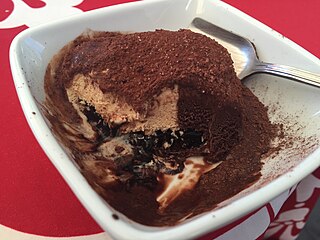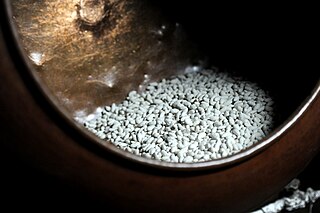
Dessert is a course that concludes a meal. The course consists of sweet foods, such as candy, and possibly a beverage such as dessert wine and liqueur. In some parts of the world there is no tradition of a dessert course to conclude a meal.

Nutella is a brand of sweetened hazelnut cocoa spread. Nutella is manufactured by the Italian company Ferrero and was first introduced in 1964, although its first iteration dates to 1963.

Cake is a flour confection made from flour, sugar, and other ingredients and is usually baked. In their oldest forms, cakes were modifications of bread, but cakes now cover a wide range of preparations that can be simple or elaborate and which share features with desserts such as pastries, meringues, custards, and pies.

Pralines are confections containing nuts – usually almonds, pecans and hazelnuts – and sugar. Cream is a common third ingredient.

Kissel or kisel (Estonian: kissell, Finnish: kiisseli, Livonian: kīsõl, Latgalian: keiseļs, Latvian: ķīselis, Lithuanian: kisielius, Polish: kisiel, Russian: кисель, tr.kiselʼ, Ukrainian: кисiль,, Belarusian: кісель, is a simple dish with the consistency of a thick gel. It belongs to the group of cold-solidified desserts, although it can be served warm. If the kissel is made less thick, it can be drunk — this is common in Poland, Belarus, Russia and Ukraine.

Milka is a Swiss brand of chocolate confectionery, originally made in Switzerland in 1901 by Suchard. It has then been produced in Lörrach, Germany from 1901. Since 2012 it has been owned by US-based company Mondelez International, when it started following the steps of its predecessor Kraft Foods Inc., which had taken over the brand in 1990. It is sold in bars and a number of novelty shapes for Easter and Christmas. Products with the Milka brand also include chocolate-covered cookies and biscuits.

Chocolate syrup is a sweet, chocolate-flavored condiment. It is often used as a topping or dessert sauce for various desserts, such as ice cream, or mixed with milk to make chocolate milk or blended with milk and ice cream to make a chocolate milkshake. Chocolate syrup is sold in a variety of consistencies, ranging from a thin liquid that can be drizzled from a bottle to a thick sauce that needs to be spooned onto the dessert item.

An icebox cake is a dairy-based dessert made with cream, fruits, nuts, and wafers and set in the refrigerator. One particularly well-known version used to be printed on the back of boxes of thin and dark Nabisco Famous Chocolate Wafers.

Caramel shortbread, also known as caramel squares, caramel slice, millionaire's shortbread, millionaire's slice, chocolate caramel shortbread, and Wellington squares is a biscuit confectionery item composed of a rectangular, triangular or circular shortbread biscuit base topped with caramel and milk chocolate. Variations exist which substitute or add ingredients to cater to different tastes, dietary requirements or ingredient availability.

Chocolate is a food product made from roasted and ground cocoa pods mixed with fat and powdered sugar to produce a solid confectionery. There are several types of chocolate, classified primarily according to the proportion of cocoa and fat content used in a particular formulation.
Tiffin is a form of cake-like confection composed of crushed biscuits, sugar, syrup, raisins, cherries and cocoa powder, often covered with a layer of melted striped chocolate. It was created in Troon, Scotland, in the early 1900's.Unlike regular cakes, Tiffin does not require baking. Instead, following preparation of the mixture, the confection is chilled until set. As a consequence the product may also be known as "fridge cake" or another similar term.

Chocolate salami is an Italian and Portuguese dessert made from cocoa, broken biscuits, butter, eggs and sometimes alcohol such as port wine or rum. The dessert became popular across Europe and elsewhere, often losing alcohol as an ingredient along the way.

Tartufo is an Italian dessert of gelato that originated in Pizzo, Calabria. The dessert takes the form of a ball that is composed of two or more flavors of gelato, often with melted chocolate inserted into the center or alternatively, with either fruit syrup or frozen fruit—typically raspberry, strawberry, or cherry—in the center. Typically, the dessert is covered in a shell made of chocolate or cocoa, but sometimes cinnamon or nuts are used.
The following outline is provided as an overview of and topical guide to chocolate:

Sponge cake is a light cake made with egg whites, flour and sugar, sometimes leavened with baking powder. Some sponge cakes do not contain egg yolks, like angel food cake, but most of them do. Sponge cakes, leavened with beaten eggs, originated during the Renaissance, possibly in Spain. The sponge cake is thought to be one of the first of the non-yeasted cakes, and the earliest attested sponge cake recipe in English is found in a book by the English poet Gervase Markham, The English Huswife, Containing the Inward and Outward Virtues Which Ought to Be in a Complete Woman (1615). Still, the cake was much more like a cracker: thin and crispy. Sponge cakes became the cake recognized today when bakers started using beaten eggs as a rising agent in the mid-18th century. The Victorian creation of baking powder by English food manufacturer Alfred Bird in 1843 allowed the addition of butter to the traditional sponge recipe, resulting in the creation of the Victoria sponge. Cakes are available in many flavours and have many recipes as well. Sponge cakes have become snack cakes via the Twinkie.

Semolina pudding or semolina porridge is a porridge-type pudding made from semolina, which is cooked with milk, or a mixture of milk and water, or just water. It is often served with sugar, cocoa powder, cinnamon, raisins, fruit, or syrup. A similar consistency to rice pudding can also be made by using more semolina and by baking, rather than boiling.

Candy making or candymaking is the preparation and cookery of candies and sugar confections. Candy making includes the preparation of many various candies, such as hard candies, jelly beans, gumdrops, taffy, liquorice, cotton candy, chocolates and chocolate truffles, dragées, fudge, caramel candy, and toffee.

Supangle or sup is a type of Turkish chocolate pudding. Its bottom layer includes pieces of cake and it is often garnished with pistachio or coconut, and chocolate chips.

Biscuit cake is a type of no bake tea cake, similar to American icebox cake, found in Irish, English, Danish, Arabic, Bulgarian and Jewish cuisine. It is made with digestive biscuits and is optionally prepared with a chocolate glaze.
Pie in American cuisine has roots in English cuisine and has evolved over centuries to adapt to American cultural tastes and ingredients. The creation of flaky pie crust shortened with lard is credited to American innovation.

















